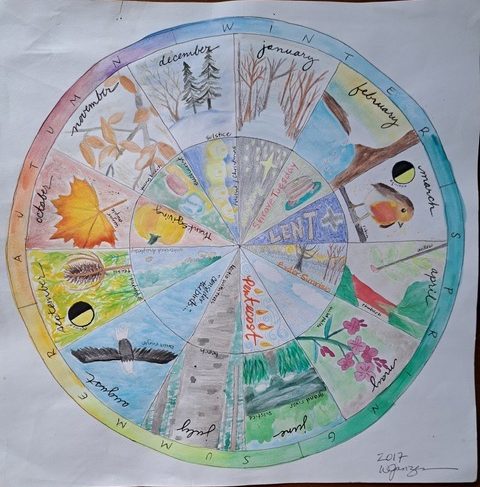by Wendy Janzen
At Burning Bush Forest Church, we meet once a month for outdoor worship, and once a month for a learning/serving/action/community building event. To supplement those events, we offer an eco-spiritual practice of the month for people to explore on their own.
What is an eco-spiritual practice? There are a variety of ways this could be defined, depending on who you are and how you approach ecospirituality. As a Christian pastor and spiritual director, I see eco-spiritual practices as invitations to explore and deepen our spiritual lives through activities that invite contemplative connections with creation and creative or embodied expression of our response to God’s presence there. To some, they may seem far from a typical prayer practice, but as I read somewhere, anything can be a prayer when we bring that intention to it. eco-spiritual practices invite us into the wondrous, to nurture our spirit and connect with God.
The eco-spiritual practice we are currently exploring is creating a phenology wheel. Phenology is the study of cyclic and seasonal natural phenomena, especially in relation to climate and plant and animal life. A phenology wheel is a way to record what we are noticing in the circle of the year. To make it a spiritual practice, an added element of recording the liturgical calendar or a spiritual insight connected to each month, adds another layer of paying attention. Because it is a wheel, you can begin this practice at any time of year.
I first discovered the phenology wheel in 2016 (on the Raising Little Shoots website), the same year I founded Burning Bush Forest Church. It appealed to me as a personal practice to aid in deepening my own awareness of God’s activity and presence with me in nature as I led others in outdoor worship. I sensed that if I was going to be leading a different kind of worshiping community I needed new and different kinds of spiritual practices to ground me in my ministry. It was an enlightening experience, one that opened me to engaging with the cycles of nature in ways that also nurtured my faith.
To engage with this as an eco-spiritual practice, create your own template using whatever you have on hand – I used the back of some scrapbooking paper, a dinner plate and a ruler to create my template with a bit of trial and error (This time around I am switching to watercolor paper).
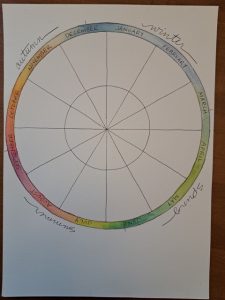
Once you have your template at the ready, turn your attention to what you notice around you each month. Take leisurely walks, gaze out the window, notice weather patterns, track the changes in daylight or moon cycles, watch for wildlife. See what captures your attention and take time to connect and reflect.
To quote Mary Oliver’s Instructions for Living a Life, “Pay attention. Be astonished. Tell about it.” Pay attention each month to what astonishes you. What captures your curiosity? Observe the ordinary and the unusual. Then tell about it through creative expression. You may want to take pictures or keep a journal through the month to help you notice patterns or significant moments.
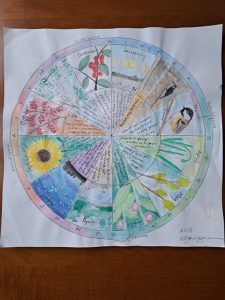
When the inspiration hits, or at the end of the month, pull out your template and whatever art supplies you have on hand. Use the outer part of the wedge to express what rises to the surface when you think about connecting with creation this month. Don’t worry about your artistic ability – this isn’t for show.
Use the inner part of the wedge to somehow record what resonated with your spirit or interior life this month – a ritual, a holy day, particular words, a mood. Is there any intersection between what you are noticing and the liturgical season you are in (if you are from a tradition that follows liturgical seasons)? Does your experience bring to mind a scripture verse or line of poetry? Does it inspire a prayer? Does it have anything to show you about God’s presence and revelation in creation?

Be playful, open-minded and open-hearted with this practice. My hope is that this practice
- encourages you pay attention to your surroundings better
- deepens your sense of connection to your watershed and with the other creatures in the community of creation
- affects your sense of time and the changing seasons
- inspires you to see God in creation, and helps to see creation as a revelation of God’s compassionate and ongoing presence on earth.
NOTE: As an Amazon Associate I receive a small amount for purchases made through appropriate links.
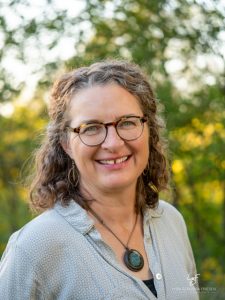
Wendy Janzen is pastor of Burning Bush Forest Church, an experimental faith community that began gathering for outdoor worship in the Grand River watershed in 2016. She is also one of the co-founders of the Wild Church Network, serves as Eco-Minister for Mennonite Church Eastern Canada, and is a spiritual director. As someone who left childhood believing she was not artistic or creative, she is enjoying exploring new creative outlets as a response to God’s creative activity in the world.
“Be in touch with what is wondrous, refreshing, and healing both inside and around you.” (Brian McLaren)
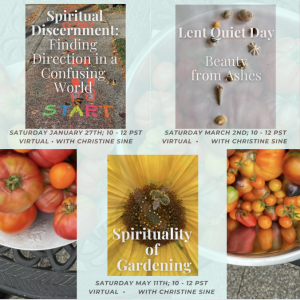 Christine Sine is offering three virtual retreats this winter: Spiritual Discernment: Finding Direction in a Confusing World, Lent Quiet Day: Beauty from Ashes, and Spirituality of Gardening. Register for all three retreats here.
Christine Sine is offering three virtual retreats this winter: Spiritual Discernment: Finding Direction in a Confusing World, Lent Quiet Day: Beauty from Ashes, and Spirituality of Gardening. Register for all three retreats here.

